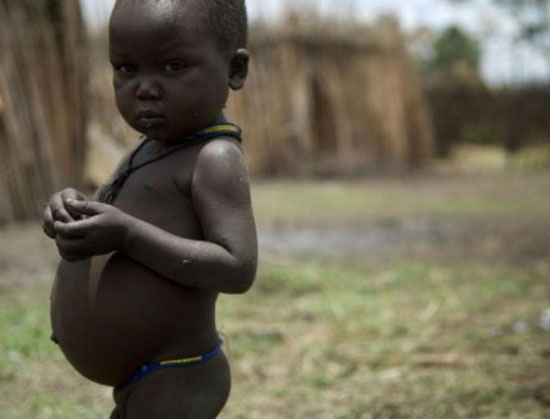10 million Africans are at risk of drought
The UN has just warned: nearly 10 million people in the Horn of Africa in East Africa are facing a humanitarian emergency because the region struggles with the worst drought in 60 years. years ago.
>>>Drought threatens Europe

A malnourished child at Karramoja, in Uganda, one of the least developed areas of East Africa.
The United Nations Food and Agriculture Organization (FAO) said the climate behind the drought is caused by La Nina, a periodic meteorological phenomenon affecting rainfall in Africa and other continents.
The main reason is drought that causes a food crisis, there are also other factors including regional conflicts, especially in Somalia, where thousands of people have to go to refugees.
Crisis is increasing due to rising prices of food and fuel. ' At present, livestock farmers who have to sell 5 goats can buy a 90 kg bag of corn, compared with two one sack in January , "according to Stephanie Savariaud of the World Food Program of UN
According to the latest figures from the UN Humanitarian Affairs Office (OCHA), the relief area includes 3.2 million people in Ethiopia, 3.5 million in Kenya, 2.5 million in Somalia, 600 000 in northeastern Uganda and 120 thousand in Djibouti.
However, the big challenge appears in Somalia and Ethiopia where about 65% of the population are farmers who earn their living by raising and grazing cattle. Many pets have died because of dehydration due to chemical. This means they are deprived of their only source of income and food. Mr Ahmed said the lack of investment in roads and shopping centers also meant that shepherd farmers lost their roads to get rich, the only way to help them through harsh times.
The early international hunger warning system (FEWS-NET), operated by USAID, also produced data on the magnitude of the drought. The researchers compared the total rainfall in 2010 with historical data from 1950 to 2011. The results show that 2010 and 2011 were the driest and second years in 11 of the 15 sheep production areas.
' Current drought is very harsh, further its impact is more serious due to high food prices, reduced coping capacity, and limited humanitarian aid ,' analysis of FEWS-NET concluded.
FAO economist Shukri Ahmed said the cause of the drought was La Nina phenomenon. He said, ' We have predicted La Nina phenomenon in the past 6 months. When it happens, there will be a limited area in the east and flash floods in the south. '
Mr Ahmed said that FAO has repeatedly issued warnings about the consequences of La Nina, but too little planning for precautions has been made. This is the reason for the lack of 40% of the budget needed to overcome the crisis, FAO said.
Satellite data analyzed by David Grims of the University of Reading, UK also reflects the harsh situation of the current drought. He said the rainfall has decreased in three consecutive rainy seasons in Cape Africa. Normally, there are two rainy seasons each year; from mid-March to May, and between mid-October and December. Of which, April is the peak rainy month of the year.
' Normally, there will be between 120 and 150 millimeters of rainwater in April, but satellite data say there are probably only about 30 to 40 millimeters in April this year .'
Although it is also concluded that La Nina is the main cause of the current drought, Mr. Grimes also said other weather factors are also relevant. That is the ocean temperature on the Indian surface is higher than normal. This causes more rain in the sea than on land.
The biggest risk now is that rain will continue to fall during the next rainy season, Dan Williams of the UK Met Office, judged. He also stressed that it is currently impossible to say whether this drought is the result of climate change.
- EU warns the risk of drought across Europe
- China: Drought causes 7.5 million people to lack drinking water
- Severe drought, the US carries 30 million salmon to the sea
- Drop 96 million plastic balls into the lake to combat drought
- Drought spreads causing serious damage in China
- Record drought in China
- Millions of Africans are affected by floods
- Drought affects millions of Chinese people
- Human anti-drought weapons are here
- More than half of America has suffered from drought
- Some plants make drought worse
- Italy: Po River shrinks due to drought
 Is the magnetic North Pole shift dangerous to humanity?
Is the magnetic North Pole shift dangerous to humanity? Washington legalizes the recycling of human bodies into fertilizer
Washington legalizes the recycling of human bodies into fertilizer Lightning stone - the mysterious guest
Lightning stone - the mysterious guest Stunned by the mysterious sunset, strange appearance
Stunned by the mysterious sunset, strange appearance